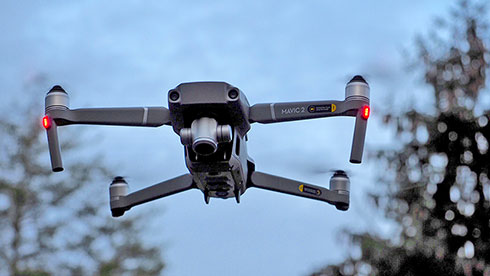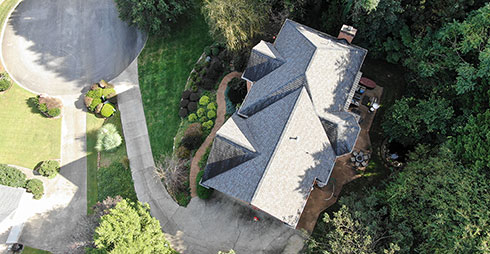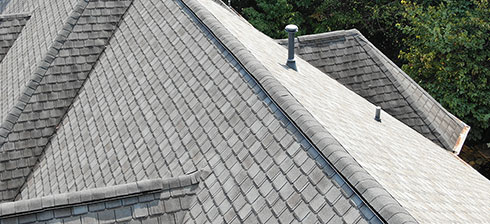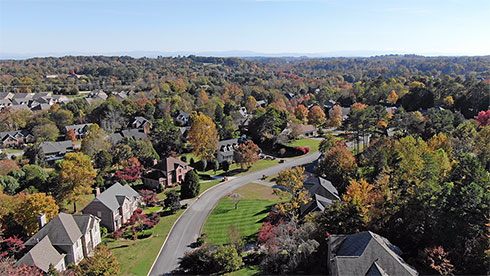« How bright is your screen? | Main | Android contemplations 2019 »
March 25, 2019
The Drone in Your Future
Drones have made tremendous progress and will likely become part of many jobs.
In this article I will provide a brief overview of drone technology, and the application and impact it may have on field operations. Because, believe it or not, drones may well become part of your job.
Not too terribly long ago I came across an article and an accompanying YouTube video by a man who had attached a small digital camera to a remote controlled toy helicopter. The contraption worked well enough to yield video from high above the trees around his house. It was a fun project, the man felt, and there might actually be practical application for such a thing. But most who watched the video probably dismissed it as just a weird hobbyist science project.
What the man may or may not have known was that he may well have cobbled together one of the first "drones" as we know them today. I say "as we know them today" because unmanned aircraft that could shoot pictures have been used as far back as the Spanish American War in the late 1800s, back then mounted to a kite. The actual term "drone" apparently dates back to the mid-1930s when unmanned remote-controlled vehicles made the buzzing sound of hive-controlled male bees, or "drones."
Drones as we know them today are of much more recent vintage. They came about when "action cameras" like GoPros became small and light enough to be mounted onto inexpensive little helicopters, usually with four rotors. Available both as cheap toys and also as more serious flying cameras, drones quickly gained a reputation as intrusive pests used by paparazzis and other intruders of privacy, and also as a danger to real aircraft.
That has gotten to a point where the use of drones is more and more regulated, and sadly in a haphazard and uneven way that frustratingly varies from place to place.
So let's see where drones are today and where they may be headed. Yes, you can pick up a cheap drone at every Walmart or similar store for very little money. Those do take video and they do fly, but they don't do either well. As a result, most quickly crash or get lost. They may be kids toys, but since most lack any degree of stabilizing electronics, they are actually difficult to control and fly.
Those willing to spend more money will find a rapidly increasing degree of sophistication. Here at RuggedPCReview.com we invested in one of the latest drones of market leader DJI (which commands almost 3/4 of the market). The Mavic 2 Zoom retails for US$1,299, which is in the range of more serious consumer digital cameras.

For that you get a remote-control quad-copter drone with a 12-megapixel camera with 2x optical zoom and full gimbal movement. The Mavic 2 weighs about two pounds, its four rotor arms, each with its own little electric motor, twist away for compact storage, and it can fly for about half an hour on a charge of its removable 60 watt-hour battery. The remote controller works in conjunction with an iPhone or Android smartphone, which mean you'll see live video right on your phone, and it can even live-stream it to social media.
Now lest you think drones like the Mavic 2 are still just toys, this thing can go as fast as 45 miles per hour, it can go as high as 1,600 feet, it can be up to five miles away from the controller, and it has a (battery-limited) flying range of about 11 miles.
Thanks to GPS and numerous sensors, the Mavic 2 drone also has amazing smarts. It can follow preset GPS coordinates/waypoints. And it recognizes obstacles and will navigate around them. It has all sorts of programs, like following the pilot, fly circles around a still or moving object, do special effects, and so on. And it also has a bunch of LEDs so it can be seen in bad light, and also to communicate status.
How difficult is it to control a drone like the Mavic 2? That depends on one's dexterity and how much learning time is invested. Any video game player will be right at home with the controller. There are different flight modes, including a restricted beginner mode. There are helpers such as auto-launch, and also auto-return and auto-land. What perhaps is most amazing is how rock-solid the Mavic 2 is in the air. If you let go of the controls, it sits still in the air as if on a tripod. Even modest wind doesn't faze it. You can leisurely peruse the scenery from high up there, looking any which way you want.
But now let's look at what all that means for field workers and the typical users of rugged mobile computers.
Quite obviously, being able to control a camera that can fly has enormous potential. It can easily go anywhere and anyplace where ladders, scaffolds, and potentially dangerous trekking would otherwise be needed. That makes it ideal for inspections, damage assessment whether it's the big picture from way above or from very close-up. It can be used to take breathtaking video of real estate, natural settings, bridges, tall buildings and plenty more. It can go inside of structures that may be unsafe. The application potential is endless.



Sounds almost too good to be true, doesn't it. But it's all real, and it's only going get to get better and ever more sophisticated. The small 12-megapixel camera not enough? For a mere $200 more, DJI offers the same quadcopter setup with a 20-megapixel Hasselblad camera. Need a bigger drone with some payload capacity? They are available. Need a bigger screen? You can hook the controller up to a tablet. Is the screen not bright enough? DJI offers a controller with its own sunlight-viewable display.
And then there are the laws and regulations. Even for a small drone like the DJI Mavic 2, the controller insists on downloading the latest regulations and restrictions before each and every flight. If too close to a sensitive area, one may have to get permission to fly first. And anything that is considered commercial use of a drone requires a license. It's not terribly difficult to get, but still requires studying and passing a test. And depending where you are, the law of the land may make little legal difference between flying a drone and flying an actual aircraft.
That all said, it's easy to see that drones will likely become tools for the job for many field and other workers who now use rugged mobile electronics. So the sooner you start acquainting yourself with drone technology, the better off you are. -- Conrad Blickenstorfer, March 2019
Posted by conradb212 at March 25, 2019 4:28 PM















